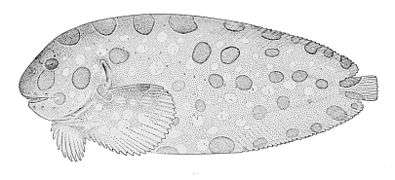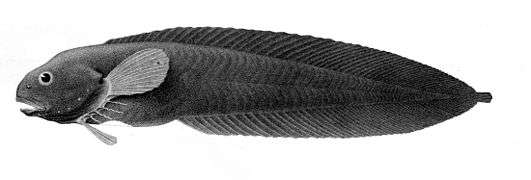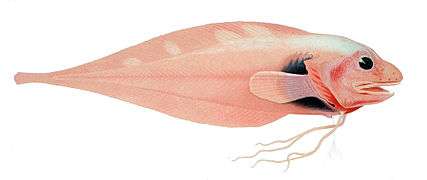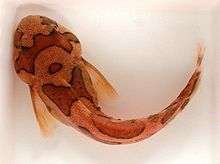Snailfish
| Snailfish | |
|---|---|
 | |
| Snailfish (probably Elassodiscus tremebundus) caught in the eastern Bering Sea | |
| Scientific classification | |
| Kingdom: | Animalia |
| Phylum: | Chordata |
| Class: | Actinopterygii |
| Order: | Scorpaeniformes |
| Family: | Liparidae T. N. Gill, 1861 |
| Type genus | |
| Liparis Scopoli, 1777 | |

The Liparidae, commonly known as snailfish or sea snails,[1] are a family of scorpaeniform marine fishes. Widely distributed from the Arctic to Antarctic Oceans including the northern Pacific, the snailfish family contains about 30 genera and 410 species.[2] They are closely related to the sculpins of the family Cottidae and the lumpfish of the family Cyclopteridae. Snailfish are sometimes included within the latter family.
Description
The snailfish family is poorly studied and few specifics are known. Their elongated, tadpole-like bodies are similar in profile to the rattails. Their heads are large (compared to their size) with small eyes; their bodies are slender to deep, tapering to very small tails. The extensive dorsal and anal fins may merge or nearly merge with the tail fin. Snailfish are scaleless with a thin, loose gelatinous skin; some species, such as Acantholiparis opercularis have prickly spines, as well. Their teeth are small and simple with blunt cusps. The deep-sea species have prominent, well-developed sensory pores on the head, part of the animals' lateral line system.
The pectoral fins are large and provide the snailfish with its primary means of locomotion although they are fragile. They are benthic fish with pelvic fins modified to form an adhesive disc; this nearly circular disc is absent in Paraliparis and Nectoliparis species. Snailfish range in size from Paraliparis australis at 5 cm (2.0 in) to Polypera simushirae at some 77 cm (30 in) in length. The latter species may reach a weight of 11 kg (24 lb), but most species are smaller. Snailfish are of no interest to commercial fisheries.
Occurrence and habitat
The habitats chosen by snailfish are as widely variable as their size; they are found in both shallow intertidal zones and at depths of 7,500 m (24,600 ft) or more, in both cold and warm waters. The diminutive inquiline snailfish (Liparis inquilinus) of the northwestern Atlantic is known to live out its life inside the mantle cavity of the scallop Placopecten magellanicus. Liparis tunicatus lives amongst the kelp forests of the Bering Strait and the estuary of the St. Lawrence River. The single species in genus Rhodichthys is endemic to the Norwegian Sea.[3] Other species are found on muddy or silty bottoms of continental slopes. Snailfish are abundant in most (especially polar) waters and are highly resilient.
In October 2008, a UK-Japan team discovered a shoal of Pseudoliparis amblystomopsis at a depth of 7.7 km (4.8 mi) in the Japan Trench.[4]
In December 2014, an unknown species of snailfish was spotted by a probe in the Mariana Trench at a depth of 8,143 m, breaking the previous record for the deepest living fish seen on video.[5]
Reproduction
Reproductive strategies are also known to vary among the species. At least one species, the Careproctus ovigerus of the North Pacific, is known to practice mouth brooding; that is, the male of the species carries the developing eggs around in his mouth. All species are known to lay a small number (about 300) of relatively large eggs (4.5–8 mm in diameter). Other species of the genus Careproctus lay their eggs in the gill cavities of king crabs.
Diet
The diet of snailfish consists primarily of small benthic crustaceans, mollusks, polychaete worms, and other small invertebrates. Some species are also piscivorous. Specialist species such as Paraliparis rosaceus feed exclusively on sea cucumbers.
Genera
This family currently contains these genera:
- Acantholiparis Gilbert & Burke, 1912
- Aetheliparis Stein, 2012 [6]
- Allocareproctus Pitruk & Fedorov, 1993
- Careproctus Krøyer, 1862
- Crystallichthys Jordan & Gilbert, 1898
- Eknomoliparis Stein, Meléndez C. & Kong U., 1991
- Elassodiscus Gilbert & Burke, 1912
- Eutelichthys Tortonese, 1959
- Genioliparis Andriashev & Neyelov, 1976
- Gyrinichthys Gilbert, 1896
- Liparis Scopoli, 1777
- Lipariscus Gilbert, 1915
- Lopholiparis Orr, 2004
- Menziesichthys Nalbant & Mayer, 1971
- Nectoliparis Gilbert & Burke, 1912
- Notoliparis Andriashev, 1975
- Osteodiscus Stein, 1978
- Palmoliparis Balushkin, 1996
- Paraliparis Collett, 1879
- Polypera Burke, 1912
- Praematoliparis Andriashev, 2003
- Prognatholiparis Orr & Busby, 2001
- Psednos Barnard, 1927
- Pseudoliparis Andriashev, 1955
- Pseudonotoliparis Pitruk, 1991
- Rhinoliparis Gilbert, 1896
- Rhodichthys Collett, 1879
- Squaloliparis Pitruk & Fedorov, 1993
- Temnocora Burke, 1930
- Volodichthys Balushkin, 2012 [7]

.jpg) Careproctus ovigerus (juvenile)
Careproctus ovigerus (juvenile) Crystallichthys cyclospilus
Crystallichthys cyclospilus Elassodiscus tremebundus
Elassodiscus tremebundus

 Paraliparis bathybius
Paraliparis bathybius

References
| Wikimedia Commons has media related to Liparidae. |
- ↑ "The Sea Snails. Family Liparidae". Gulf of Maine Research Institute. Retrieved March 6, 2012.
- ↑ Froese, Rainer, and Daniel Pauly, eds. (2015). "Liparidae" in FishBase. February 2015 version.
- ↑ Hogan, C.M. (2011): Norwegian Sea. Encyclopedia of Earth. Eds. Saundry, P. & Cleveland, C.J. National Council for Science and the Environment. Washington DC
- ↑ Morelle, R. (2008). "'Deepest ever' living fish filmed". BBC News.
- ↑ http://www.schmidtocean.org/story/show/3584
- ↑ Stein, D.L. (2012): A Review of the Snailfishes (Liparidae, Scorpaeniformes) of New Zealand, Including Descriptions of a New Genus and Sixteen New Species. Zootaxa, 3588: 1–54.
- ↑ Balushkin, A.V. (2012): Volodichthys gen. nov. New Species of the Primitive Snailfish (Liparidae: Scorpaeniformes) of the Southern Hemisphere. Description of New Species V. solovjevae sp. nov. (Cooperation Sea, the Antarctic). Journal of Ichthyology, 52 (1): 1–10.
